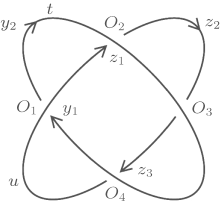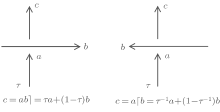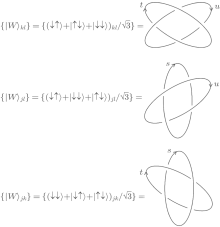†Corresponding author. E-mail: swqian@pku.edu.cn
The GHZ states and W states are two fundamental types of three qubits quantum entangled states. For finding the knotted pictures of three nodes W states, on the one side, we empty any one node, thus obtaining three degenerated two-node W states, then we find the nonzero submatrix of the corresponding covariance correlation tensor in quantum network theory. On the other side, excepting the linkage 41 corresponding to Bell bases, we conjecture that the another one possible oriented link (which is composed of two-component knots entangled with each other and has four crossings) would be the required knotted pictures of the two nodes W states, thence obtain the nonzero submatrix of the Alexander relation matrix in the theory of knot crystals for these knotted pictures. The equality of the two nonzero submatrices of different kinds thus verify the exactness of our conjecture. The superposition of three knotted pictures of two-node W states from different choices of the emptied node gives the knotted pictures of three-node W states, thus shows the correspondence between three-node W states in quantum network theory and the oriented links in knot theory. Finally we point out that there is an intimate and simple relationship between the knotted pictures of GHZ states and W states.
Because of the very importance of quantum entanglement[1– 13] we try to find the connection between entangled states and oriented links in knot theory, [14– 16] and have successfully found such deep connections.[17– 31] Recently, based on our previous works about the correspondence between four Bell bases and four oriented links 41 in knot theory, [17, 18] and the correspondence of eight GHZ quantum entangled states and eight oriented links 121 in knot theory, [19] furthermore, we have shown that there exists a very simple and vivid way of obtaining the linkage 41 by using the method of torus knot theory.[30] Firstly we find the knotted picture of Bell bases (number of qubits m = 2) on the surface of trivial torus, the torus link K4, 2, then after quitting the trivial torus and projecting the torus link on a plane, we can easily obtain the knotted pictures of Bell bases, the linkage 41. Similarly on the ordinary plane, [30] we find the knotted picture of eight GHZ quantum states (number of qubits m = 3) on the surface of trivial torus, the torus link K6, 3, then after quitting the trivial torus and projecting the torus link on a plane, we can easily obtain the knotted pictures of eight entangled GHZ quantum states, and the linkage 121, on the ordinary plane.[31] In general, for m qubits GHZ states we have shown that the knotted picture of 2m oriented links can be represented by the torus link K2m, m on the surface of trivial torus.[31] From all our research about the relationship between entangled states and oriented links we can confidently draw the following conclusions: there exists the correspondence between entangled quantum states and oriented links in knot theory; every qubit corresponds to its own knot in the oriented link corresponding to the given entangled state; this correspondence can be used to predict some new undiscovered entangled states and related phenomena.
However, all our previous research was limited to generalized GHZ states; however, in 2000 the authors in Ref. [12] pointed out that there are two fundamental types of entangled quantum states, the GHZ states and W states for 3-node quantum entangled states. So, what kinds of oriented links correspond to the W states? This paper aims at solving this problem. From the method of discovery of the correspondence between four Bell bases and four oriented links of the linkage 41 in knot theory, [14– 16] we already know that, on the one hand, we must find the covariance correlation tensor (CCT) in the theory of quantum network for the W states, on the other hand, we should find the Alexander relation matrix (ARM) in the theory of knot crystals for the W states, then by the comparison of obtained results, we can confirm the exactness of the correspondence between W states and their corresponding knotted pictures.
The organization of this paper is arranged as follows. In Section 2 we are going to find the matrix of CCT of the degenerated 2-node W state from the theory of quantum networks. In Section 3 we shall conjecture another possible oriented link (which is composed of two component knots entangled with each other and has four crossings) as the knotted picture of the 2-node W state and find the nonzero submatrix of the ARM of the conjectured linkage from the theory of knot crystals. We find that the nonzero submatrix of the CCT exactly equals the nonzero submatrix of the ARM of the conjectured 2-node W state, thus confirming our conjecture about the knotted picture of 2-node W states. From the 3-node W states |W 〉 jkl, we can obtain three different kinds of degenerated 2-node W states, which are |W 〉 kl, |W 〉 jl or |W 〉 jk. Thus, when we have obtained their corresponding knotted pictures, the superposition of these knotted pictures will give the knotted pictures of 3-node W states. Hence the correspondence between quantum entangled states and oriented links in knot theory is also true for W states. Comparison of the knotted pictures of Bell bases (i.e. 2-node GHZ states) with those of the conjectured 2-node W states, we find that the latter pictures are just the results obtained by the application of the surgical operation flip in knot theory on the third crossing of the former pictures. This is the intimate and simple relationship between GHZ states and W states in knot theory.
Firstly we will give the definition of CCT for a quantum network of two nodes (m = 2). Quantum network[13] is a system consisting of m subsystems (nodes) interacted with each other in n-dimensional Hilbert space. Let ν be the ordinal numbers of the nodes, s be the dimensionality of the generating operator of SU


where λ j is the expectation value of 

In the case n = 2, s = n2 − 1 = 3, 


In the case of two nodes, for example, ν = 2, 3, the density operator 
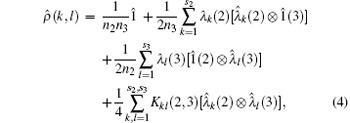
where 

The CCT Mkl(2, 3) is introduced as[13, 17, 20, 21]

For a quantum network of three nodes, the density operator 



Equation (4) can be written as[13, 17, 20, 21]

When Mkl(k, l) = 0 for all possible k and l, equation (7) becomes the product state 
The value of a qubit is taken to be zero and one for | ↓ 〉 and | ↑ 〉 respectively. In the case of a system of two nodes m = 2, we know that there are four basic product states, which are |↓ ↓ 〉 = |00〉 = |1〉 , |↓ ↑ 〉 = |01〉 = |2〉 , |↑ ↓ 〉 = |10〉 = |3〉 and |↑ ↑ 〉 = |11〉 = |4〉 . From these four basic product states we construct four Bell bases, which are 

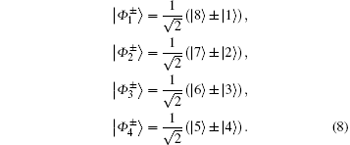
Dü r et al.[12] pointed out that there are only two types of entangled states for a quantum network of three nodes: GHZ states and W states. The eight GHZ states are constructed from two basic product states for a quantum network of three nodes, as shown in Eq. (8), whereas the eight W states (four quantum states 


In our two previous papers, [17, 18] we have discussed the correspondence between four Bell bases and the four oriented links of the linkage 41 in knot theory, [14– 16] and the correspondence between GHZ states and the oriented links of the linkage 121 in knot theory.[19] Now we shall use the same method to find the correspondence of eight W states |W〉 jkl and the eight expected oriented links in knot theory.
We already know that eight GHZ states |GHZ〉 jkl will degenerate into four Bell bases under the condition that any one qubit disappears, hence |GHZ〉 kl, |GHZ〉 jl, and |GHZ〉 jk all correspond to four Bell bases. Similarly, the eight W states |W〉 jkl will degenerate into four unnamed degenerated entangled states under the condition that any one qubit disappears (i.e., |W〉 kl, |W〉 jl or |W〉 jk). In this section we shall go to find the CCT Mkl of the unnamed degenerated entangled states |W〉 kl. Without loss of generality, we choose one W state 

The general expression of a pure state is[13, 21, 22]

where | μ 〉 = | k 〉 ⊗ | l 〉 = | k, l〉 is a product state. The density operator of the pure state |χ 〉 is

where 

The corresponding components of coherent vectors are

where the unit operator and generating operators are

Substituting Eqs. (9), (10), and (14) into Eq. (13) we obtain
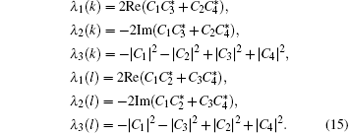
For degenerated W state |W〉 kl,

Using Eq. (16), from Eq. (15) we obtain

From Eqs. (16), (17), (4), and (5) after a long and tedious calculation we obtain

Using the definition of CCT

we obtain the matrix of CCT for degenerated W state |W〉 kl:

It is well known that in the case of 3-nodes (j, k, l), there are two types of quantum entangled states, the GHZ states and W states. We have already discovered the knotted pictures of GHZ states ({|GHZ〉 jkl}).[19, 31] When we empty any one node, then the obtained results {|GHZ〉 kl}, {|GHZ〉 jl}, {| GHZjk} are just the correponding knotted pictures of the Bell bases, which have the largest degree of entanglement of the linkage 41. The linkage 41 is a collection of two component knots, [17] it has four crossings when one component knot j (its ring parameter is s, for oriented knot, s+ and s− denote the anticlockwise and clockwise directions of this knot respectively[17]) crosses another component knot k (its ring parameter is t, for an oriented knot, t+ and t− denote the anticlockwise and clockwise directions of this knot respectively[17]). There are two types of crossing, one is over-crossing when j crosses over k, another is under-crossing when j crosses under k. We already know that the Bell bases correspond to the linkage 41 where over-crossing and under-crossing appear alternatively. When the two-component knots are still entangled with each other, then the only case for the distribution of four crossings for the linkage 41 is the case where one under-crossing followed by three over-crossings (or equivalently, one over-crossing followed by three under-crossings), whose degree of entanglement is apparently less than that corresponding to Bell bases. Now we will derive the ARM for this case, and find that the nonzero submatrix of the 4 × 4 ARM just equals Eq. (20), thus we verify that this type of the linkage 41 is just the knotted picture of the required knotted picture {| W〉 kl}, hence from the supperposition of {| W〉 kl}, {| W〉 jl}, {| W〉 jk} we can readily obtain the knotted pictures of {| W〉 jkl}.
Now we empty the node j, and investigate the linkage 41 composed of two-component knots k and l (its ring parameter is u, for oriented knot, u+ and u− denote the anticlockwise and clockwise directions of this knot respectively[17]) in which one under-crossing is followed by three over-crossings. In Fig. 1 we give the supposed knotted picture, the directions of two-component knots are all chosen to be clockwise, O1, O2, O3, and O4 are four crossings, in which the first one is under-crossing, the others are over-crossings. Note that if we change O3 from over-crossing to under-crossing, then figure 1 becomes the knotted picture of the Bell basis 
There are two modes of crossings, the right cross b⌉ and the left cross ⌈ b, they will serve to encode the two oriented types of diagrammatic crossings as shown in Fig. 2.
As illustrated in Fig. 3, the incoming under-crossing arc is a, the emanating arc is c, the over-crossing arc is b, then we denote c = a b⌉ for the right cross, or c = a⌈ b for the left cross, here ab⌉ and a⌈ b are defined by the following equations

where a, b ∈ M, M is any module over the ring Z(τ , τ − 1), τ is the ring parameter. The ring parameters of the two-component knots are t and u for unoriented knots, and t+ , u+ or t− , u− for oriented knots with anticlockwise or clockwise direction respectively. The relations between these ring parameters are given by the following equations

Now we shall use Eqs. (21) and (22) to derive the ARM of the knotted picture shown in Fig. 1. From Fig. 1 we easily see that the arc y2 emanating from the crossing O1 is the same as the arc y1 incoming into the crossing O1, i.e., y2 = y1, hence y2 = y1z1⌉ becomes y1 = y1z1⌉ . Using Eq. (21) for the four crossings and noting that y2 = y1, we get

Using Eq. (22) to arrange Eq. (23) we get%

The coefficient matrix of the variables y1, z1, z2, z3 of Eq. (24) is

Using the method of a combination of rows and the method of a combination of coulumbs separately and repeatedly (see Appendix A), we can easily obtain

From Eq. (26) we readily obtain the non-zero submatrix A3× 3(t, u)

Thus we verify that the non-zero submatrix A3× 3(t, u) exactly equals (Mkl), hence we can say that figure 1 is just the required knotted picture of the quantum entangled state | W〉 kl, i.e., {| W〉 kl}. Similarly we can easily find the knotted pictures corresponding to the cases when we empty the node k (i.e., {| W〉 jl}) and the node l (i.e., {| W〉 jk}) respectively. The knotted pictures of all these 2-node W states are given in Fig. 3.
The superposition of all these 2-node W states readily gives the common 3-node W state as shown in Fig. 4.
Note that oriented crossings in Fig. 4 are labelled with a plus or minus sign, when we can rotate the oriented over-crossing anticlockwise with an acute angle in order to coinside with the oriented under-crossing. The oriented crossing is called a positive crossing, if clockwise, then it is called a negative crossing. In Fig. 4, there are nine positive crossings and three negative crossings. In Fig. 1, crossings O1, O2, and O4 are positive, whereas crossing O3 is negative. In knot theory there is a surgical operation flip, [28] which changes the sign of the crossing, i.e. from positive to negative or from negative to positive, when we apply flip on crossing O3, then O3 becomes positive, then figure 1 becomes just the knotted picture of the Bell basis | Φ − 〉 .[17] Furthermore, when we apply the flip on the right three negative crossings, then figure 4 becomes the knotted picture of one of the eight GHZ states.[19, 31] Hence we can from the knotted pictures of GHZ states obtain those of W states just by the application of the surgical operation flip, or vice versa. This is the very important and very simple interrelations of the two fundamental types of the 3-node entangled quantum states: GHZ state and W state.
| 1 |
|
| 2 |
|
| 3 |
|
| 4 |
|
| 5 |
|
| 6 |
|
| 7 |
|
| 8 |
|
| 9 |
|
| 10 |
|
| 11 |
|
| 12 |
|
| 13 |
|
| 14 |
|
| 15 |
|
| 16 |
|
| 17 |
|
| 18 |
|
| 19 |
|
| 20 |
|
| 21 |
|
| 22 |
|
| 23 |
|
| 24 |
|
| 25 |
|
| 26 |
|
| 27 |
|
| 28 |
|
| 29 |
|
| 30 |
|
| 31 |
|



